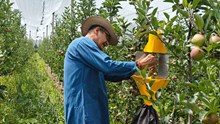
India’s forests and farmlands are home to many plants with deep roots in traditional healing and local livelihoods. Among them stands the white bilwa, also called the marking nut tree, a deciduous species revered in Ayurveda and local folk medicine. Botanically known as Semecarpus anacardium, this tree is often overlooked in modern agriculture but holds tremendous potential especially for farmers in dry and degraded areas. The tree produces a black, kidney-shaped fruit called the marking nut, once used to mark fabric, but more importantly, it is now valued for its medicinal oil and therapeutic compounds.
The white bilwa tree has adapted well to arid and semi-arid regions across central and southern India, particularly in the states of Madhya Pradesh, Maharashtra, Chhattisgarh, and Odisha. What makes it appealing is not just its hardy nature but its multiple uses from herbal remedies to oil extraction. These characteristics make it a candidate for diversification in both forestry and mixed cropping systems.
Climate and Soil Suitability
The white bilwa tree thrives in warm climates and requires relatively low rainfall, ranging between 500 mm to 1000 mm annually. It prefers open, sunny areas with well-drained, rocky, or lateritic soils and performs best at elevations up to 1000 meters above sea level. Farmers living in regions where traditional crops struggle due to soil infertility or erratic rainfall can consider this tree as a sustainable alternative.
This hardy plant does not require fertile land. In fact, it is often seen growing wild on rocky slopes, along bunds, or even in barren patches. Once established, it requires minimal maintenance and is resistant to drought and most pests, making it ideal for marginal lands.
Propagation and Planting
Propagation of the white bilwa tree is generally done through seeds. Seeds are collected from mature fruits, usually during the dry season (February to April). Before sowing, the seeds are often soaked in water or cow dung slurry to soften the hard seed coat and improve germination.
Seeds are sown directly in polybags or nursery beds and allowed to germinate over 20 to 30 days. The saplings can be transplanted into the field after 6–8 months, once they have grown to about 30–45 cm in height. The ideal spacing between two trees is about 5 meters. The best planting season is during the monsoon, as the natural rainfall helps the young trees establish themselves without additional irrigation.
Care and Maintenance
Once planted, the white bilwa tree requires minimal care. In the first year, occasional watering during dry spells and protection from grazing animals are the main concerns. Light weeding and mulching can help retain soil moisture and suppress competing weeds. Organic compost or farmyard manure may be added at the base during the early years to enhance growth, although the tree is capable of surviving without chemical fertilizers.
Unlike many commercial crops, this tree does not demand constant care. It is well-suited to agroforestry systems, where it can be grown alongside other hardy species or integrated into silvi-pastoral models, providing shade and fodder.
Harvesting and Processing
The tree starts bearing fruit from the fifth or sixth year onward, with full yield potential after 10–12 years. The fruits mature between January and March and are collected once they turn black and dry. Care must be taken during handling, as the juice or oil from the shell is caustic and can irritate the skin. Farmers typically use gloves or apply oil to their hands to avoid direct contact.
The nuts are dried in the sun before being processed. The main product is the oil extracted from the pericarp, used in Ayurveda to treat a variety of ailments including arthritis, respiratory issues, and nerve disorders. The inner kernel is sometimes consumed in very small quantities after detoxification, though this should only be done under expert guidance due to potential toxicity.
Market and Income Potential
With the rising demand for Ayurvedic formulations and plant-based medicines, the marking nut has found a niche market. Its oil is used in traditional medicine, hair care, and pain-relief formulations. While the prices can vary depending on quality and demand, processed marking nut oil can fetch between Rs. 500 to Rs. 1,000 per kilogram in the herbal product industry.
Farmers can either sell the dried nuts directly to local traders or collaborate with Ayurvedic companies and herbal cooperatives for better prices. Setting up small-scale processing units, with proper safety measures, could further enhance value addition and income.
Medicinal Importance and Traditional Uses
White bilwa has been used for centuries in Unani and Ayurvedic systems. Traditionally, it is applied externally to treat joint pain, skin disorders, and boils. Internally, after detoxification, it is said to improve digestion, treat respiratory issues, and act as a nerve tonic. Its anti-inflammatory and antimicrobial properties have been backed by modern research as well, reinforcing its relevance in contemporary medicine.
Conservation and Sustainable Use
Given its role in traditional medicine and its resilience to harsh environments, the white bilwa tree deserves greater attention in India’s agroforestry and conservation programs. Overharvesting and habitat loss have affected its wild populations in some regions. By cultivating it on farms, not only can farmers earn sustainable income, but they can also contribute to preserving this culturally significant species.
The white bilwa tree is a hidden gem in Indian agriculture. It is low on input, high on value, and deeply rooted in our traditional knowledge. For farmers in rain-scarce or difficult terrains, it offers a practical, profitable, and ecologically friendly option. With growing interest in herbal and alternative medicine worldwide, trees like the white bilwa can help build resilient farm incomes while preserving our natural and cultural heritage.
















